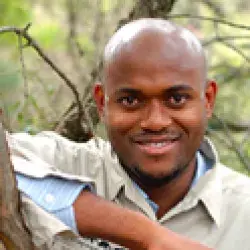Meet Nnzumbeni Tshikalange
I would like to introduce you to Nnzumbeni Tshikalange who is running the Limpopo Leopard Project for the next few months. Nnzumbeni hails from the Limpopo Province near Thohoyandou, the capital city of the former Venda. She obtained her bachelor degree in Zoology from the University of Limpopo.
[caption id="attachment_1238" align="aligncenter" width="300" caption="This is a bit dark, but here I am with Nnzumbeni."] [/caption]
[/caption]
Prior to my departure from the field, I had the opportunity to spend three days with Nnzumbeni. The aim was to introduce her to the study site and see if she would be interested in a life in the bush. On the first day we were lucky to find numerous samples, leopard scats to be specific (three). These we collected and I was happy to see that Nnzumbeni was keen to have a go at collecting some of them. In the process we went out to check the cameras. There was a lot of walking in the sun, but it was fun at the same time.
The following day we went out to track Gudzane male, the leopard we collared in January. The previous weeks I had tried in vain to locate the animal, mainly because it so happened that there was a buffalo cow with the same frequency collar in the study area. The interesting thing about this buffalo that I hope you will appreciate as much as I do is that it was collared about 150 km south of the leopard study site. I guess no one anticipated that she would migrate that far.
Anyway, the first time I went out to try and locate Gudzane male and the telemetry pointed me into a herd of breeding buffalo, I was baffled because it meant that the leopard must have been surrounded by the buffalo. Was the leopard trying to get one of the calves? Did the buffaloes trample on our study animal and destroy it? These were some of the questions that ran through my head. I decided to approach them in the vehicle (my fort) and realised that perhaps the herd was too large, some of the bulls were already starting to follow the car half curious and half threatening. I decided to leave them there and try the following day instead.
The following day I went to the same spot and there was no signal, instead the signal pointed in the direction I came from. I followed up on the signal and guess what I found after one and a half hours of searching? Buffaloes! Is this leopard a Buffalo fan, following them wherever they go like an obsessed fan following their hero? That was my day two question. I decided to stay with the herd this time. There must have been around one hundred of them. The signal pointed directly into the herd. That was an interesting thing to see.
I was wondering how I was going to explain this kind of behaviour. “A leopard that thinks he is a buffalo,” that would make a nice piece of story to tell. Suddenly the herd sort of moved and out walked this cow sort of trying to tell me not to get my hopes high about finding a leopard among the herd. Around her neck was a collar and the signal pointed directly at her. I took her picture and disappointed I headed back to the lodge. After that it became my routine, following a buffalo cow. It turns out that the telemetry equipment responded to the buffalo collar more than it did for the leopard collar. In the end Dr. Peter Buss decided it was enough and came and removed the buffalo collar.
[caption id="attachment_1233" align="aligncenter" width="300" caption="Mystery solved: It turned out the leopard collar was competing with the collar on this buffalo."] [/caption]
[/caption]
The collar removal coincided with Nnzumbeni’s arrival, hence after the buffalo collar was removed I was excited to go out and find the cat. He had been out of sight for five weeks at that point. We woke up early the following day and headed out in search of the leopard. The leopard was nowhere to be found. We searched the whole concession. We even went as far as Olifants Camp, which is to the north of our study site, but there was no success. To this day the leopard is yet to be found.
On the third day, there was an opportunity to wash the scat that I had been collecting in the last year. Nnzumbeni enjoyed that as well ,and by the end of the day we had washed all the scats in the stockings and left them out to dry. The following day I took Nnzumbeni to the bus station. After that I went to Skukuza, where I was going to attend the annual Kruger Park Network Meeting and to present my findings in the first year of study.
In the next post Nnzumbeni will talk about her experience in the field.
